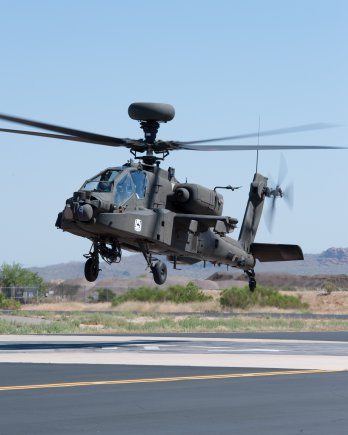Army planners are rethinking how their service will acquire 700 AH-64E Apache attack helicopters over the next 14 years in light of declining procurement budgets. InsideDefense reported on March 6 that the Army’s fiscal 2014 budget request will defer any new production of the service’s airborne tank-killer until 2018 at the earliest, relying entirely on remanufactured airframes to introduce vital technology upgrades into the force.
The service had planned to buy 56 new-build Apaches in the latest “E” configuration during the remainder of the decade at a cost of $2 billion, in the process preserving specialized industrial skills at the program’s integration facility in Mesa, Arizona. But budget cuts have forced planners to drop that part of the helicopter modernization plan, at least for now.
Remanufacture of legacy airframes and vehicles has become an increasingly common practice in the Army as the service struggles to reconcile readiness requirements with the need to introduce life-saving technologies into its combat systems. The latest “E” variant of the Apache will equip the helicopter with improved communications links, more powerful engines, more durable rotor blades, and the ability to control remotely-piloted drones. Collectively, those upgrades enable the Apache to cruise at higher speeds, climb faster, and carry more gear — enhancements that are necessary to cope with the gains potential adversaries are making in their own combat systems.
The Army still plans to spend $12 billion remanufacturing over 600 Apaches at a rate of about one per week, but that will depend on the availability of funding to keep the program on track in future years. Since it first debuted in 1986, Apache has been a core component of the service’s force structure. It is widely regarded as the most capable attack helicopter in the world, able to engage fixed and moving ground targets day or night in any weather conditions with its 30mm chain gun, Hydra rockets and Hellfire missiles.
The helicopter has been used extensively in Iraq and Afghanistan, greatly reducing the threat to U.S. ground forces by precisely attacking enemy combat formations. Boeing is the prime contractor for the program, with advanced sensors — radars and targeting infrared systems — supplied by Lockheed Martin and Northrop Grumman.
The Army’s decision to revise its plans for Apache is just the latest indication of how budget cuts are eroding the industrial base for key warfighting systems. Although most of the Army’s future operational requirements for the Apache can be met through remanufacture of existing airframes, some skills needed to build rotorcraft will be lost as a result of the decision to delay new builds.
The service is also planning to shut its last two armored-vehicle production facilities in Ohio and Pennsylvania, and to end manufacture of Humvee light trucks at the sole assembly site in Indiana. The Apache decision thus is part of a broader collapse in the ground-combat industrial base that will largely deprive the nation of the surge capability needed to respond quickly to unexpected contingencies in the future.










